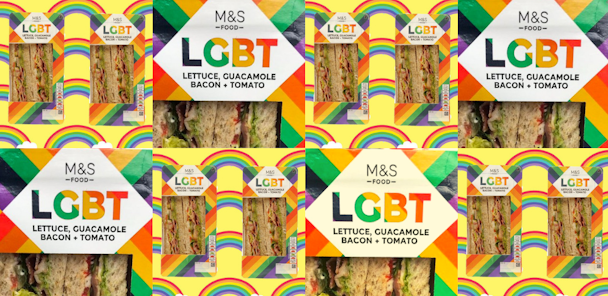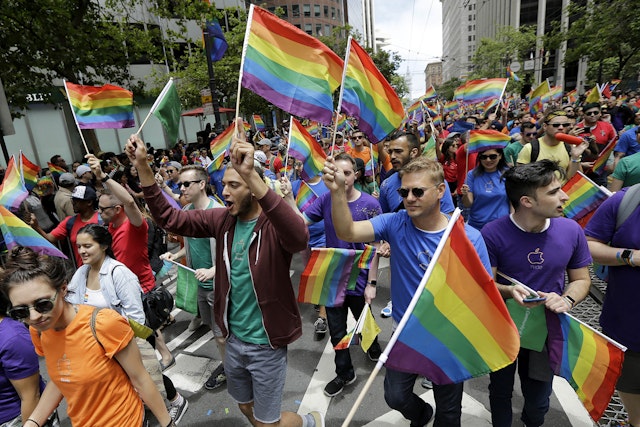
Advertisement

The 3 sins of LGBTQ+ marketing: riding the Pride bandwagon
To kick off The Drum’s three-part series about the biggest mistakes brands make when it comes to LGBTQ+ marketing and how to avoid them, we explore how advertisers can authentically fly the rainbow flag during Pride Month and beyond to enact meaningful change.
As with many high-profile movements, brands see World Pride Month as an ample opportunity to unleash their inner ‘woke’ and showcase the ways in which they care about more than just their bottom line.
However, in recent years and months it’s become clear that when advertisers do raise their heads above the parapet and engage with issues outside their typical remit, they also open themselves up to accusations of insincerity and virtue signalling.
Increasingly, companies are showing solidarity with the Pride movement through glossy campaigns, themed merch and more. In the last month alone, Marks & Spencer divided opinion with its LGBT sandwich (which features lettuce, guacamole, bacon and tomato on white bread) and Sainsbury’s drew derision from some corners of the LGBTQ+ community for its “superficial” Pride greetings cards.
Elsewhere, Smirnoff has been praised for its Soho Angels initiative, that enlists a team of specially trained volunteers to keep the LGBTQ+ community safe at night throughout the year. This year, the drinks brand is bringing the volunteers to Pride, to ensure the safety of its attendees.
Throughout June, LGBTQ+ people and their allies will take to the streets in parades and events across the globe.
However, in a world where authenticity is increasingly important to consumers, brands need to be careful that their Pride initiatives are flying the flag in a way that actually drives change and supporting LGBTQ+ causes in the process.
As part of a three-part series from The Drum exploring the three pitfalls of LGBTQ+ marketing, and how advertisers can navigate this space while enacting real change, we explore how brands can avoid riding on the Pride bandwagon.

Synonymous with the month of June parades, ‘Pride’ means so much more to the LGBTQ+ community than a stream of vibrant floats chugging through air thick with rainbow coloured confetti.
Instead, it is an overarching outlook that opposes ‘shame’ by definition and bolsters LGBTQ+ rights movements 365 days of the year, not just for one day or one month.
2019 marks 50 years since the momentous New York Stonewall Riots that changed the course of LGBTQ+ history forever, and pathed the way for years of activism, protests and victories that have lead to Pride as we know it today.
Although it was born from protest, Pride is also a celebration of love.
“Pride is a fantastic space for visibility and for people to come together,” explains Asad Dhunna director of communications for Pride in London and founder of The Unmistakables. “But in the time we live in and with the far right on the rise, we need brands to move the conversation from one day a year to 365.”
Although the trend of decriminalising anti-sodomy laws across the world has gained currency, there are still 11 countries that prescribe the death penalty for homosexuality. And despite years of campaigning by the transgender rights movement, it was only last month the World Health Organisation (WHO) no longer categorised being transgender as a “mental disorder.”
In these cases, ‘Pride’ is far more than a parade for brands to tap into, and in some cases, the cause Pride stands for can be the difference between life and death.
"If you look at the issues that are facing even the UK, where we're seeing news related to the Muslim community clashing with the LGBTQ+ community. It's two minority groups against one another," Dhunna says.
"And therefore, should brands be getting involved in that conversation? Should brands take a stand?" he questions.
Whenever brands put on their purpose hats and engage with high-profile political issues such as Pride, they open themselves up for criticism.
According to the 2018 Edelman Earned Brand study, nearly two-thirds of consumers around the world will buy or boycott a brand solely because of its position on a social or political issue, showing there's a business case for cause-based marketing even though it's a risky bet.
In large part, criticism is relevant to authenticity; customers will notice when brands apathetically try to flog Pride products by slapping on a rainbow in the hope of appearing aware and engaged.
A study conducted by the Data and Marketing Association last year found 86% of consumers said authenticity was important when deciding what brands they like and support.

In 2019, Primark was at the receiving end of criticism when it as accused of piggybacking on the Pride movement, without giving anything back. As part of a partnership with British LGBTQ+ charity Stonewall, the cut-priced clothing company designed a range of Pride merchandise which would see 20% of proceeds go to the charity – not Pride.
Many criticised Primark’s decision, asking why cash-strapped local Pride organisers were getting none of the money.
At the time, Steve Taylor, the co-founder of the UK Pride Network and communications director at EuroPride called Primark out for making the shirts in Turkey and Bangladesh - countries where LGBTQ+ rights are heavily suppressed, and homosexuality is illegal.
Yesterday, @Primark and @stonewalluk announced a partnership where Primark sell their 'Pride range' across the UK and western Europe and donate 20% of profits to Stonewall. I asked some questions, but got no answers. So I'll try again. A thread pic.twitter.com/gl9JWwuMrf
— Steve Taylor (@danophile) May 22, 2018
“The Primark T-shirts are printed where Pride is illegal so that is deeply unethical. The issue for me is where the message on the T-shirt is printed," he complained.
“It is unfair to ask people to do the messages in countries where LGBT rights are a pipe dream and we must not do it.”
One way brands are now showing solidarity is by flying the rainbow flag – a universal symbol claimed by the LGBTQ+ community. A cursory glance on Facebook or Twitter will who a multitude of household names adopting the symbol.
Although greater viewership to the flag undoubtedly strengthens the fight for liberation, it is seen by some as an easy cop-out for brands who want to seem like they’re involved in the global march towards decriminalisation and equality in the absence of any definitive action from their business.
“It serves a purpose but it shouldn’t be used as a sticker,” explains Asad “It’s a bit like Fairtrade. You wouldn’t slap a Fairtrade logo on something without checking each stage of the supply chain.”
According to Joe Parker, account manager at Karmarama and co-founder of the agency's internal LGBTQ+ network, Pridearama; for brands to ensure the use of the rainbow flag is authentic, it comes down to understanding what it really stands for.
“The rainbow flag’s origin lies in the roots of queer activism and protest,” he says.
“Advertisers must understand that queer people fought for those rights, not brands or corporates and they must rethink if the rainbow flag is right for any communications whatsoever.”
The thing about the rainbow flag it needs a prevailing wind to keep it waving throughout the year when the Pride gales die down.
“We’re fed up with people slapping a rainbow flag on something and pretending they cared for a month,” says Ethan Spibey, owner of Proud Beers - an enterprise that supports the LGBTQ+ community by donating money from every beer bottle sold. “Bullying in schools doesn’t just happen in July,” he adds.
In response to this, he and his partner created something with the LGBTQ+ community in its very heart, not just as an afterthought.
Proud Beer seeks to redefine the way that the LGBTQ+ community is supported by directly donating 20p to its charity partners every time it sells a bottle of its LGBTQIPA beer – and its not just a limited-time offer just for Pride, it continues throughout the year.

“If you're trying to sell more products for more profit during June, you're rightly going to get the scrutiny you deserve,” Spibey says. “But, if you're creating a truly genuine product that centres on supporting the community and does so in collaboration and partnership with charities and community initiatives, then that will shine through.
Not all LGBTQ+ communications have to start from the first of June until the end of July, says Stephen Brown, global marketing manager at Absolut Vodka.
“Take it out of season,” he explains. “If you're launching a product and there are two people kissing within that product shot, do they have to be straight? It's very simple, it’s just representation rather than it's a gay advert.”
What it comes down to is representation, adds Brown. If you're brave enough to say where you stand as a brand and show that support, that’s great but if the people working on the campaigns aren't people of experience within that community then you really need to bring in those who are.

For 35 years, Absolut has proudly represented the LGBTQ+ community, with its campaigns, workforce and supporting Britain’s largest LGBTQ+ charity, Stonewall and GLBTQ Legal Advocates & Defenders (GLAD) in the United States. It makes sure that it’s talking to people who clearly understand the narratives of what should be portrayed.
On the whole, the majority of the brands who are representing the LGBTQ+ community do so with the intent to be positive and say the right thing:“It's just their experience and representation behind the camera that might be stopping the true narrative that they should be portraying,” finishes Brown.